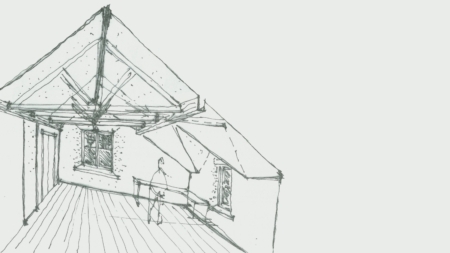Heating with a Match
We started with a meadow ringed by tall trees and the idea of putting up a house that would fit with both its forest neighborhood and our small family.
Green as we were about house construction—which is to say inexperienced and naïve—we had an agenda: Our new house had to be built with environmentally sound materials, locally produced where possible; it had to be energy-efficient; and it had to be comfortably warm. We were building in the north woods, where winter temperatures routinely drop below freezing for months on end, and the house would have to shelter us from that.
In the library we read about straw-bale houses, yurts, not-too-big houses, solar houses, passive-solar houses, superinsulated houses. They were like sects of the same religion, and we would get fired up by one, only to be swayed by another. The central issue was heat—how to have enough of it without burning tankers of fuel, and how to keep the heat in the house once it was there. By the time we came away from the drawing board we had a passive-solar, somewhat actively solar, superinsulated, not-too-big-but-certainly-big-enough house, a house that, our contractor said, “could be heated with a match.”
Still, when the slabs of rigid foam insulation that were going to be wrapped around the house frame were unceremoniously dropped off in the yard one day, we wondered if something that looked like packing materials for a computer really would be an adequate barrier between us and the cold. Later, when the foam boards were backed up by “wet cellulose” insulation—essentially, soggy pellets of ground up newspaper—we wondered again. And then there was the boiler. Not much bigger than your average suitcase, it was sized for a house half as big as ours. We had to take it on faith that with its foam jacket and triple-paned thermal windows, our house needed nothing more substantial.
The foundation was poured as soon as the frost went out of the ground. A team of Percherons, driven by our neighbor John, a horse logger, arrived a few weeks later to cut and haul the spruce and hemlock trees that would make the timber frame. Meanwhile, Vermont Family Forests, an organization that helps small landowners manage their woodlots sustainably, located a stand of recently harvested beech for our floors and trim. (Americans don’t much like beech because it has too much “character,” we were told. Most of it gets shipped to Sweden. Our load came 15 miles on the back of a flatbed truck.)
As the house began—slowly—to take shape, we went shopping for appliances (memorizing whole constellations of energy star ratings) as well as for counters, faucets, carpets, lights. We found a dishwasher and a washing machine that used less than half of what average machines use. We ordered dedicated compact fluorescent light fixtures and showerheads with “eco” settings. We learned of a company that makes countertops out of condensed recycled paper bags—it’s true—and a woman in Alaska who fashions glass tiles from discarded bottles. (Gorgeous, but too expensive for us, especially with the transportation costs.)
Closer to home, the local flooring store sold us carpets conjured out of truck tires and plastic soda containers, as well as a roll of “organic” “linoleum.” There was nothing natural about the decking material we bought at the lumberyard, as our resident porcupine learned the night she snacked on the newly installed entryway stairs. It, too, was the reincarnation of plastic soda bottles.
Eventually, a bank of solar panels was installed above the living room, and then a solar hot-water heater. Rather than being off the national power grid, whatever excess energy was captured on our roof would be put back into it.
We moved in three weeks before the first snow fell. Not long after that the temperature tumbled below zero and just stayed there. Some days the difference between inside and out was 80 or 90 degrees. No matter, who could tell? The propane tank rarely needed to be replenished yet the house stayed warm. We basked—sunlight pouring through triple panes of low-e glass—in our ignorance.
This story was first published in the Summer 2005 Catalog.

